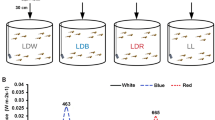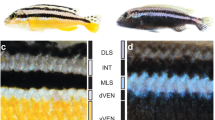Abstract
Flatfishes display a left–right asymmetry that is unique in the animal kingdom. In order to clarify the mechanisms of the asymmetrical development of pigment cells, changes in pigment cell densities were examined in Japanese flounder Paralichthys olivaceus. During development from symmetrical larvae to asymmetrical juveniles, pigment cell densities were monitored on the skin on both the left side (ocular side in juvenile; eventually has two eyes) and the right side (blind side in juvenile; eventually has no eyes). A symmetrical and constant decrease was observed in leucophores and larval type melanophores. A mostly symmetrical (slightly delayed on the blind side) and constant increase in iridophores from metamorphosis was observed. Adult-type melanophores appeared and then increased only after metamorphosis on the ocular side. However, the pattern of xanthophores was complicated: they first existed symmetrically and decreased symmetrically until metamorphosis, and they later increased only on the ocular side. The dual appearance of the xanthophores, as well as the differences between their depths and sizes on the ocular and blind sides, may suggest the presence of two types of xanthophores—just as melanophores are well known to exhibit two types. The ontogenetic study of pigment cells described here is likely to help to elucidate the process of abnormal pigmentation in flatfishes.




Similar content being viewed by others
References
Seikai T (1997) Mechanism of abnormal pigmentation. In: Minami T, Tanaka M (eds) Biology and Stock Enhancement of Japanese Flounder. Koseisha Koseikaku, Tokyo, pp 63–73 (in Japanese)
Bolker JA, Hill CR (2000) Pigmentation development in hatchery-reared flatfishes. J Fish Biol 56:1029–1052
Seikai T, Matsumoto J, Shimozaki M, Oikawa A, Akiyama T (1987) An association of melanophores appearing at metamorphosis as vehicles of asymmetric skin color formation with pigment anomalies developed under hatchery conditions in the Japanese flounder, Paralichthys olivaceus. Pigment Cell Res 1:143–151
Seikai T (1992) Process of pigment cell differentiation in skin on the left and right sides of the Japanese flounder, Paralichthys olivaceus. Jpn J Ichthyol 39:85–92
Minami T (1982) The early life history of a flounder Paralichthys olivaceus. Bull Jpn Soc Sci Fish 48:1581–1588 (in Japanese)
Seikai T (1985) Influence of feeding periods of Brazilian Artemia duirng larval development of hatchery-reared flounder Paralichthys olivaceus on the appearance of albinism. Bull Jpn Soc Sci Fish 51:521–527
Haga Y, Nataami K, Takeuchi T (2005) Process of true ambicoloration in larval and juvenile Japanese flounder Paralichthys olivaceus: an ultrastructural study. Nippon Suisan Gakkaishi 71:782–790 (in Japanese)
Pederzoli A, Gambarelli A, Restani C (2003) Xanthophore migration from the dermis to the epidermis and dermal remodeling during Salamandra salamandra salamandra (L.) larval development. Pigment Cell Res 16:50–58
Seikai T (1980) Early development of squamation in relation to color anomalies in hatchery-reared flounder, Paralichthys olivaceus. Jpn J Ichthyol 27:249–255
Kikuchi SK, Makino N (1990) Characteristics of the progression of squamation and the formation of ctenii in the Japanese flounder, Paralichthys olivaceus. J Exp Zool 254:177–185
Acknowledgments
We are grateful to the staff at Miyazu Station, National Center for Stock Enhancement, Fisheries Research Agency, and those at the Niigata Prefectural Fisheries and Marine Research Institute, for kindly supplying the Japanese flounder eggs. We are also grateful to the staff and the students at the Field Science Education and Research Center, Kyoto University, for their assistance in rearing the fish and conducting experiments. This study was supported in part by Grants-in-Aid from the Ministry of Education, Culture, Sports, Science and Technology, and from the Ministry of Agriculture, Forestry and Fisheries of Japan to M. T.
Author information
Authors and Affiliations
Corresponding author
Rights and permissions
About this article
Cite this article
Nakamura, M., Seikai, T., Aritaki, M. et al. Dual appearance of xanthophores, and ontogenetic changes in other pigment cells during early development of Japanese flounder Paralichthys olivaceus . Fish Sci 76, 243–250 (2010). https://doi.org/10.1007/s12562-009-0209-7
Received:
Accepted:
Published:
Issue Date:
DOI: https://doi.org/10.1007/s12562-009-0209-7




